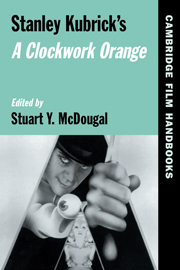Book contents
- Frontmatter
- Contents
- Acknowledgments
- List of Contributors
- Introduction: “What's it going to be then, eh?”: Questioning Kubrick's Clockwork
- 1 A Clockwork Orange … Ticking
- 2 The Cultural Productions of A Clockwork Orange
- 3 An Erotics of Violence: Masculinity and (Homo)Sexuality in Stanley Kubrick's A Clockwork Orange
- 4 Stanley Kubrick and the Art Cinema
- 5 “A Bird of Like Rarest Spun Heavenmetal”: Music in A Clockwork Orange
- REVIEWS OF A CLOCKWORK ORANGE, 1972
- “The Décor of Tomorrow's Hell”
- “A Clockwork Orange: Stanley Strangelove”
- A Glossary of Nadsat
- Filmography
- Select Bibliography
- Index
“The Décor of Tomorrow's Hell”
Review in Time, December 27, 1971
Published online by Cambridge University Press: 29 January 2010
- Frontmatter
- Contents
- Acknowledgments
- List of Contributors
- Introduction: “What's it going to be then, eh?”: Questioning Kubrick's Clockwork
- 1 A Clockwork Orange … Ticking
- 2 The Cultural Productions of A Clockwork Orange
- 3 An Erotics of Violence: Masculinity and (Homo)Sexuality in Stanley Kubrick's A Clockwork Orange
- 4 Stanley Kubrick and the Art Cinema
- 5 “A Bird of Like Rarest Spun Heavenmetal”: Music in A Clockwork Orange
- REVIEWS OF A CLOCKWORK ORANGE, 1972
- “The Décor of Tomorrow's Hell”
- “A Clockwork Orange: Stanley Strangelove”
- A Glossary of Nadsat
- Filmography
- Select Bibliography
- Index
Summary
Some movies are so inventive and powerful that they can be viewed again and again and each time yield up fresh illuminations. Stanley Kubrick's A Clockwork Orange is such a movie. Based on Anthony Burgess's 1963 novel of the same title, it is a merciless, demoniac satire of a near future terrorized by pathological teen-age toughs. When it opened last week, Time Movie Critic Jay Cocks hailed it as “chillingly and often hilariously believable.” Below, Time's art critic takes a further look at some of its aesthetic implications.
Stanley Kubrick's biting and dandyish vision of subtopia is not simply a social satire but a brilliant, cultural one. No movie in the last decade (perhaps in the history of film) has made such exquisitely chilling predictions about the future role of cultural artifacts – paintings, buildings, sculpture, music – in society, or extrapolated them from so undeceived a view of our present culture.
The time is somewhere in the next ten years; the police still wear Queen Elizabeth II's monogram on their caps and the politicians seem to be dressed by Blades and Mr. Fish. The settings have the glittery, spaced-out look of a Milanese design fair – all stamped Mylar and womb-form chairs, thick glass tables, brushed aluminum and chrome, sterile perspectives of unshuttered concrete and white molded plastic. The designed artifact is to Orange what technological gadgetry was to Kubrick's 2001: a character in the drama, a mute and unblinking witness.
- Type
- Chapter
- Information
- Stanley Kubrick's A Clockwork Orange , pp. 131 - 133Publisher: Cambridge University PressPrint publication year: 2003
- 1
- Cited by



